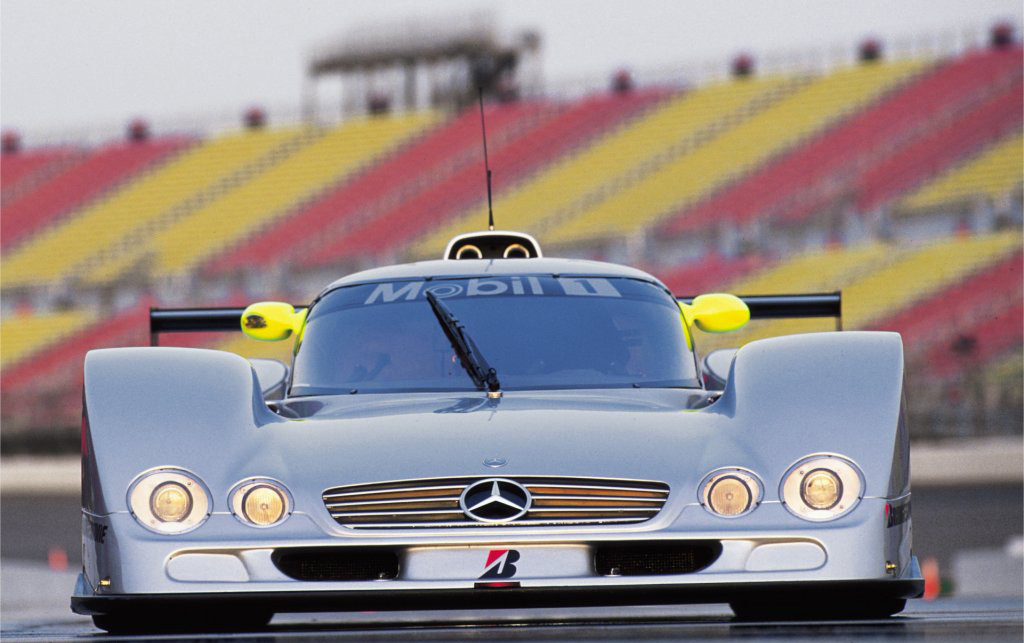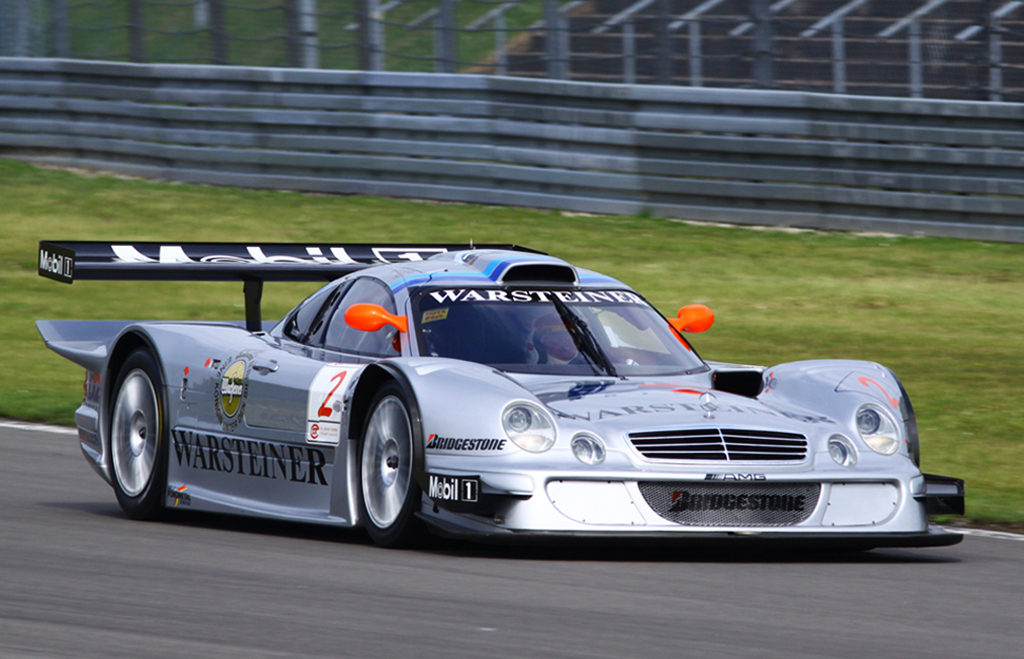Media | Articles
The “uplifting” tale of Mercedes’ troubled CLK race car program
The collapse of DTM in 1996 sent Mercedes-Benz looking for another brand-appropriate venue to flex its motorsports muscle. When the FIA introduced a new world championship—inventively dubbed the FIA GT Championship — the firm wasted no time fielding an entry. This meant that for 1997 M-B would be stepping into the top-tier GT1 ring against perhaps the two most storied marques in European racing history—Porsche and Ferrari.
The rules for the GT Championship dictated a modicum of shared design elements between the race car and a road-going counterpart from a brand’s portfolio. Mercedes tapped AMG, its dedicated speed merchants, to take the CLK coupe from luxury cruiser to rabid track rat.
The resulting CLK GTR racer was built in just six months leading up to the 1997 season. The car was extremely low, long, and wide; it looked like it was doing north of a buck-10 even when it was parked in the pits. Power came from a mid-mounted V-12 (based on the M120 12-cylinder used Mercedes’ W140 S-Class and R129 SL) driving the rear wheels. The roadgoing CLK had the engine up front, a staid silhouette generally inherited from the C-class sedan, and a choice of engines from diesel inline-four to 5.5-liter V-8.

For those keeping track at home: the race car was based on the road car about as much as Ayrton Senna was based on a turnip.
Marketplace
Buy and sell classics with confidence
Development hell
There was also the issue of homologation—every car in the GT1 class had to be built for public consumption with at least 25 road-going examples. Mercedes chose to kick this can down the road, producing one prototype in 1997 for company use and promising to build the rest of them… eventually. (More on that in a bit.)
For a headstart on its chosen architecture, Mercedes secretly purchased a McLaren F1 GTR (Chassis #11R) and started retrofitting the chassis with its own bodywork to test the aerodynamic qualities of this yet-to-be-built race car. (Who better to learn from than the best, right?)

Mercedes also swapped out the McLaren’s BMW V-12 for its own powerplant blessed by the AMG madmen from Affalterbach. This Frankenstein development car was tested relentlessly in the run-up to the 1997 season, as Mercedes needed to maximize its insights on the future car well before it saw a flag drop.
Racing for the championship
With the lessons from the development mule in hand, Mercedes set about assembling the first two prototypes a mere 128 days after the first drawings were created. The team showed up in time for the season debut and nabbed its first checkered flag in the fourth race of the year, at the 4 Hours of Nürburgring. The victory was the beginning of Mercedes hitting its stride in ‘97, winning six more races and securing the Constructors’ Championship.
In ’98, Mercedes set its sights on Circuit de La Sarthe at Le Mans, hoping to return to the winner’s circle at racing’s toughest test. To do so, some changes needed to be made. First, the car’s screaming V-12 was replaced by a V-8 based on the M119HL found in the venerable Sauber C9/C11 race cars. Then, the bodywork was modified to allow better breathing and cooling. The roofline was lowered. This modified car took a new name, as well, changing from CLK GTR to CLK LM (Le Mans).
Lessons learned from Le Mans
Sadly, the race at Le Mans didn’t pan out as Mercedes hoped. The two CLK LMs were blisteringly quick and scored a 1-2 front row in qualifying, but reliability issues forced both cars to give up the ghost just a few hours into the race.
Still, Mercedes was pleased with the changes and chose to replace the CLK GTR with the newer, sleeker CLK LM version for the rest of the 1998 FIA GT season. It wiped the floor with the competition, posting six 1-2 finishes.
The FIA GT class was canceled for the 1999 season, as Mercedes was the only one ponying up for the top-tier competition. As a result, Mercedes turned its attention to the purpose-built Le Mans Grand Touring Prototype class. There was one pesky hangup, however—Merc was still on the hook to build road-going versions of the CLK GTR. So, 25 road-going examples (20 coupes and five roadsters) were built between winter ’98 and summer ’99. They’re arguably the wildest road cars ever to wear the three-pointed star.
Enter the CLR
The next iteration, dubbed the CLR, was built expressly for the 1999 24 Hours of Le Mans. The CLR took the lessons of the CLK GTR and CLK LM and applied them to a car intended to race in a class with no homologation rules. Game on.
The impossibly low CLR ran the V-8 engine from the CLK LM and had the same CLK-inspired styling cues as the production CLK GTR road car. Which is to say, loosely inspired.

During testing ahead of the race, it became clear the CLR would not dominate the competition to come. Nevertheless, Mercedes was determined to bring the fight to Audi, BMW, and Toyota on racing’s biggest stage.
France, we have liftoff
As qualifying rolled around, issues mounted—quickly. Australian Mark Webber, a budding talent in Formula 1, took to the sky in the CLR during Thursday qualifying after the car mysteriously went airborne and backflipped before landing back on track. Terrifying.
The car was—obviously—damaged to the point of needing a significant rebuild. Mercedes made some small adjustments to the car, adding some front canards and stiffening the rear suspension in hopes of remedying the issue.

No dice.
As if the car had invisible wings, Webber went airborne again in the pre-race warmup session, this time landing on the CLR’s roof and forcing his car to retire. Still, Mercedes pressed on with the remaining CLR entrants, determined to avoid the embarrassment of bowing out. Mercedes instructed its drivers not to follow too closely behind another car, as there was very clearly a massive aerodynamics issue it would not be able to fix mid-race.
That was the final straw; Mercedes packed its bags and withdrew from the race before things got any worse. It was the second time in history that a major accident at Le Mans forced Mercedes away from top-tier competition. (For a more technical breakdown of what happened to the CLR, check out this You Tube video from Autosport.)
A fraught legacy
In hindsight, it’s clear that the CLK/CLR project was defined by haste: in its conception, in its implementation, and in an unfortunate decision to press on regardless during an extremely high-profile race. Yet there were significant victories to be had in the process, and the project did engender a handful of ludicrous street cars that still make headlines whenever they come to auction.
Will the AMG GT ably representing the company in mid-level tin-top competition around the globe, will Mercedes ever return to the top ranks of GT racing? It seems unlikely, but not because of aerodynamic concerns. Rather, it’s the open-wheeled Silver Arrows’ complete and utter dominance of Formula 1 that seems to have a lock on Stuttgart’s attention — and unlike at Le Mans, there appears to be no practical limit to how high those cars can fly.










